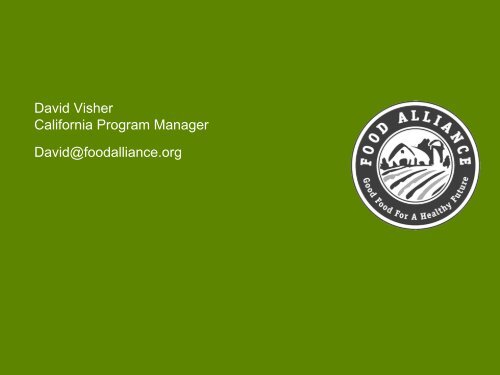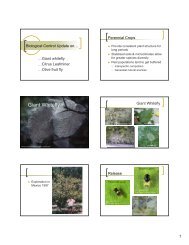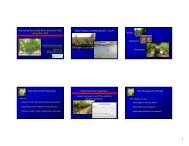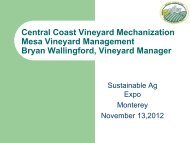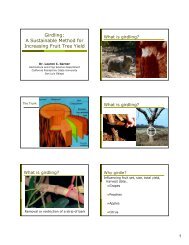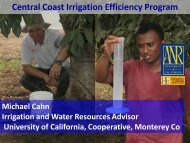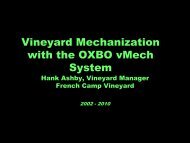Certified Sustainable by Food Alliance
Certified Sustainable by Food Alliance
Certified Sustainable by Food Alliance
Create successful ePaper yourself
Turn your PDF publications into a flip-book with our unique Google optimized e-Paper software.
David Visher<br />
California Program Manager<br />
David@foodalliance.org
Sustainability?<br />
A sustainable food system . . .<br />
Economy<br />
Community<br />
Environment
Hot Topic: toxic pesticides<br />
• USEPA: $11 billion annually on 5 billion pounds of<br />
active ingredients -- 77% for use in agriculture<br />
• USEPA: Agriculture responsible for 70% of surface<br />
water pollution<br />
• Consumers Union: 40 common pesticides a direct<br />
threat to human health<br />
• USDA: Pesticide residues detected in 61% of fruits<br />
and vegetables.
Hot Topic: global warming<br />
• Agriculture is a source of methane (animals), nitrous<br />
oxide (tillage/fertilizer) and carbon dioxide (fossil<br />
fuels, land degradation)<br />
• The average meal is estimated to travel anywhere<br />
from 1500-2500 miles from farm to plate.<br />
• Transportation of food also requires energy<br />
expenditures for food processing, packaging, and<br />
refrigeration.
Hot Topic: social justice<br />
• Over 2 million farmworkers in US<br />
-- 75% earn less than $10,000/year<br />
• Farm work is one of the most dangerous<br />
occupations in US<br />
• Very few farmworkers have health coverage
Hot Topics: wildlife habitat<br />
• Agricultural expansion is the primary cause of habitat loss<br />
and fragmentation throughout the world.<br />
• Agriculture is implicated in the decline of 40% of<br />
endangered species.
Hot Topics: family farms<br />
• Consolidation in industry and thin margins create<br />
pressure to ‘get big or get out’<br />
• “Agriculture-of-the-middle” refers to a disappearing<br />
sector of mid-scale farms/ranches (account for over<br />
80% of U.S. farmland) who are unable to<br />
successfully market bulk commodities or sell food<br />
directly to consumers.
Locally Grown <strong>Food</strong>s<br />
Family Farms<br />
Labor Conditions<br />
Animal Welfare<br />
<strong>Sustainable</strong><br />
Agriculture<br />
Toxicity – Pesticides, etc<br />
Antibiotics & Hormones<br />
Genetic Engineering<br />
Soil and Water Conservation<br />
Wildlife Habitat
Industry Takes Action<br />
KP’s Vision for a Healthy <strong>Food</strong> System:<br />
“Kaiser Permanente aspires to improve the health of our<br />
members, employees, our communities and the<br />
environment <strong>by</strong> increasing access to fresh, healthy food<br />
in and around KP facilities. We will do so in a manner<br />
that promotes agricultural practices that are ecologically<br />
sound, economically viable, culturally appropriate and<br />
socially responsible.”
A Shift in Consumer Values<br />
Value<br />
• Quality<br />
• Convenience<br />
• Price<br />
New Values<br />
• Health<br />
• Community<br />
• Environmental<br />
Stewardship<br />
• Authenticity
Consumers Today<br />
“People want to know what lies behind a brand and<br />
the extent to which its values are aligned with their<br />
own… Today, the issue is what a brand says about<br />
someone, as a badge indicative of the individual’s<br />
values and view of the world.”<br />
Chris Pomfret, Unilever Marketing Executive<br />
KP’s National <strong>Food</strong> Purchasing and Labeling Guidelines: RFI/RFP
Eco-labels<br />
Reduced<br />
Pesticides<br />
Ecosystem<br />
Friendly<br />
Animal<br />
Friendly<br />
Socially<br />
Responsible<br />
<strong>Sustainable</strong>
Eco-Labels are Credible When They Are:<br />
• Meaningful and verifiable<br />
• Consistent and clear<br />
• Transparent<br />
• Independent and free from conflict of interest<br />
• Open to public comment<br />
Consumer’s Union<br />
www.greenerchoices.org/eco-labels/
Product claims & compliance mechanisms:<br />
• 1st party claim – Promise or affidavit<br />
• 2nd party claim – Endorsement with affidavit or<br />
inspection<br />
• 3 rd party claim – Inspection <strong>by</strong> a neutral party
<strong>Food</strong> <strong>Alliance</strong><br />
<strong>Food</strong> <strong>Alliance</strong> creates market incentives for socially<br />
and environmentally responsible agricultural<br />
practices and educates business leaders and other<br />
food system stakeholders on the benefits of<br />
sustainable agriculture.
<strong>Food</strong> <strong>Alliance</strong><br />
Operates a third-party certification program and a<br />
market development program to connect<br />
sustainable growers with food businesses.<br />
• Sets standards for sustainable agriculture<br />
• Verifies compliance with standards<br />
• Helps connect sellers and buyers of certified<br />
products
<strong>Food</strong> <strong>Alliance</strong> in a Snapshot<br />
• More than 300 farms and ranches in<br />
• 5.6 million acres of range and farm land<br />
• Nearly 20 food processing and distribution facilities<br />
• $100 million of FA certified products sold in 2007
<strong>Food</strong> <strong>Alliance</strong> <strong>Certified</strong><br />
Businesses that demonstrate their compliance<br />
with our standards are granted the right to use<br />
the eco-label on certified products.
<strong>Food</strong> <strong>Alliance</strong> certifies<br />
farms and ranches that:<br />
• Raise animals without synthetic hormones<br />
and non-therapeutic antibiotics<br />
• Provide healthy and humane treatment of<br />
animals<br />
• Raise crops without genetically modified<br />
organisms (GMOs)<br />
• Reduce pesticides usage and toxicity<br />
• Conserve soil and water resources<br />
• Preserve and protect wildlife habitat<br />
• Provide safe and fair working conditions<br />
• Commit to continuous improvement of<br />
these sustainable practices
<strong>Food</strong> <strong>Alliance</strong> certifies<br />
processors and distributors that:<br />
• Use <strong>Food</strong> <strong>Alliance</strong> <strong>Certified</strong> ingredients from sustainable farms and ranches<br />
• Provide a safe and fair work environment<br />
• Conserve water and energy resources<br />
• Reduce waste through reuse and recycling<br />
• Create natural products considering purity and nutritional value<br />
• Ensure quality control and food safety<br />
• Commit to continuous improvement of these sustainable practices
Certification Process<br />
1. Voluntary application<br />
2. On-site inspection <strong>by</strong> independent auditor<br />
3. Continuous improvement goals recorded<br />
4. Inspector writes detailed report on audit results<br />
5. <strong>Food</strong> <strong>Alliance</strong> shares determination with client<br />
6. If necessary, corrective actions required and verified<br />
7. Certification granted or denied
Who’s getting<br />
certified?<br />
• Individual farms & ranches<br />
• Producer groups, Co-ops<br />
• Processors/Manufacturers
www.foodalliance.org
What does certification cost?<br />
Farms and ranches pay annual fees based on the previous year’s gross sales of the products<br />
certified:<br />
Up to $175,000<br />
.5% of sales (or base price of $400, whichever is greater)<br />
Up to $300,000 Add .25% on sales over $175,000<br />
Over $300,000 Add .10% on sales over $300,000<br />
<strong>Food</strong> processors and manufacturers pay inspection costs plus annual fees on net sales of certified<br />
products:<br />
Up to $500,000<br />
.4% of sales<br />
Up to $2 million Add .2% on sales over $500,000<br />
Up to $50 million<br />
Add .04% on sales over $2 million<br />
Over $50 million<br />
Add .02% on sales over $50 million
Lesson Learned:<br />
People buy products – not labels
Lesson Learned:<br />
Certification verifies<br />
and substantiates claims<br />
• Traceability<br />
(What is the source?)<br />
• Transparency<br />
(What are the standards?)<br />
• Accountability<br />
(Have the standards been met?)
Lesson Learned:<br />
Certification is not for everyone
Lesson Learned:<br />
Certification is not<br />
just about price premiums
Lesson Learned:<br />
Certification is a tool<br />
that supports your brand<br />
and your marketing strategies
Producers benefit most when they:<br />
• Label their products<br />
• Get marketing assistance<br />
• Invest in promotional and educational materials<br />
• Create strong, ‘high-touch’ relationships with<br />
customers<br />
• Talk about their certification and what it means
Other Benefits:<br />
• Meet customer product specifications<br />
• Manage environmental risks<br />
• Manage regulatory risks<br />
• Manage marketing risk – “stay on the shelf”<br />
• Improve community relations<br />
• Protect and enhance brands<br />
• Differentiate products<br />
• Increase customer loyalty<br />
• Gain access to new markets<br />
• Gain access to contracts<br />
• Increase sales<br />
• Feel good <strong>by</strong> “doing the right thing”
Why choose certification?<br />
• Differentiate products and enter new markets<br />
• Brand the company as an industry leader<br />
• Address customer needs and values<br />
• Demonstrate company values


